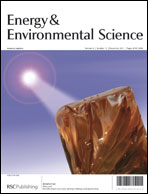Porous carbon nanofiber–sulfur composite electrodes for lithium/sulfur cells†
Abstract
Sulfur (S) encapsulated in porous carbon nanofibers (CNFs) was synthesized viaelectrospinning, carbonization and solution-based chemical reaction–deposition method. The chemical reaction–deposition strategy provides intimate contact between the S and the CNFs. This would not necessarily be the case for other reported methods, such as


 Please wait while we load your content...
Please wait while we load your content...